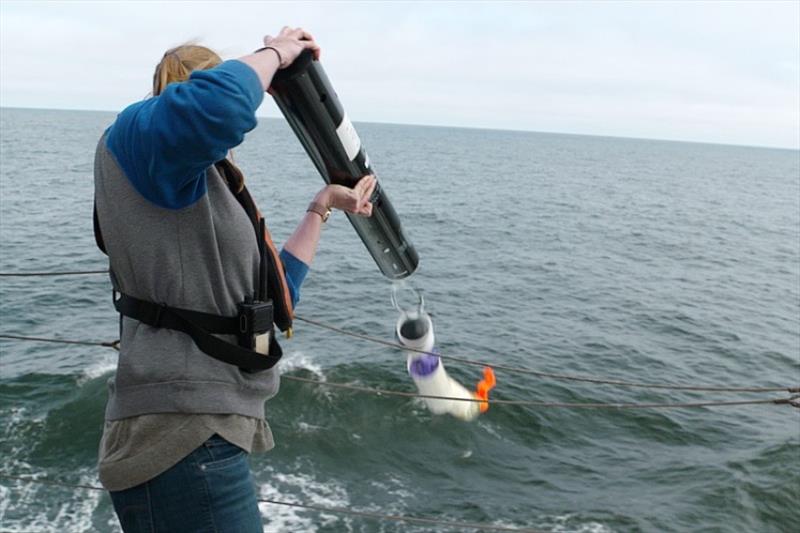
EcoFOCI Spring Mooring Cruise
by NOAA Fisheries 26 Jun 2022 01:30 HKT

EcoFOCI Spring Mooring Cruise © NOAA Fisheries
No time to waste: Data collection during transits
Blog 2 and Blog 3, we covered what the science crew accomplishes while on-station, but there's often huge chunks of time when the ship is moving from one sampling point to another. For instance, on the first day of the survey, we had a 16-hour run from Dutch Harbor to mooring site 2, home of Peggy mooring. Likewise, on Day 5, there was a 35-hour transit from Unimak Pass to mooring site 4.
The Imaging Flow Cytobot
To collect oceanographic data while transiting, the ship's survey and science crews monitor a suite of high-tech instruments. A new tool, tested for the first time on this survey, is an Imaging Flow Cytobot, aka. the IFCB.
As the name implies, this "robot" captures images of microscopic cells (the prefix 'cyto' means "of a cell") as seawater from the ship's intake valves flows through the system. This instrument targets phytoplankton, and real-time monitoring during transits is another great way to help understand the base of the food web.
In May, we are here during the spring bloom, and as images pop up on the screen, scientists take notes to identify the presence of different phytoplankton species. However, this is purely to get a general idea. Machine learning will provide the detailed analysis of the dataset, which will end up being thousands and thousands of images from this 9-day survey.
Sonobuoys - Listening for whales
The wide-open gray and choppy Bering Sea is a very hard place to visually survey for marine mammals. But, sound travels very far in water and biologists on board can also take advantage of the transit times to listen for, and possibly find, whales, specifically the North Pacific right whale.
During the many transits, the marine mammal team deployed 27 sonobuoys. These buoys have a float at the surface with underwater microphones (aka. hydrophones) hanging below that can detect sounds in real time and provide the source's direction. The acoustic signal is transmitted back to the vessel and is recorded to computers inside the ship's bridge. If whales are detected and the survey plan allows, the ship will turn toward the source of the audio, and more sonobuoys are deployed. With multiple sonobuoys tracking the direction of the whale calls, the location can be triangulated to find the whale.
While we didn't find any North Pacific right whales on this survey, sonobuoys have contributed greatly to our understanding of this highly endangered species. During this Spring Mooring Survey, we most often detected killer whales and sperm whales.
See the video below to listen to a chatty group of killer whales.
Spectrogram visualizes recordings of killer whales in the Bering Sea. This research is conducted under NMFS ESA / MMPA Permit #25563.
Wrap up
This 9-day survey was an eye-opening experience. There is so much going on and I was continually impressed at how the sea-time was maximized. It was hard to keep track of everything!
For instance, another objective accomplished on the survey was to deploy small metal Pop-up floats (PUFs). This is another instrument moored to the bottom, but releases on its own and becomes a float, measuring temperature as it drifts. Multiple floats were deployed to better understand and monitor the cold pool, a layer of cold water along the bottom of the Bering Sea. We are learning that this cold pool is super important for some species of fish and crab, and this may give researchers insight into why some species are more impacted by climate change than others.
This EcoFOCI survey is not isolated to one survey a year. In Blog 2, we mentioned that there is a fall mooring survey too. That takes place from mid-September through early October. Between the mooring surveys, there is a BASIS survey in late summer (BASIS = Bering Arctic and Subarctic Integrated Survey). This survey continues the CTD and bongo net sampling, and adds both trawl and acoustic surveys that focus on salmon and euphausiid (krill) abundance.
The coastline of Alaska is more than 2,600 miles, which is longer than all other other U.S. states combined, and a tremendous amount of area to study. More sampling across distances = better resolution of data that can tell a cohesive story when analyzed, especially with a long-term 40+ year dataset in some regions. And that's what EcoFOCI is all about. It provides foundational science to support other research, such as fisheries-dependent surveys, which are those that are focused on harvestable species and age classes.
EcoFOCI is a critical program that helps us understand the ocean and the resources in it that we depend on. It's yet another of the NOAA efforts that ensures sustainability of our coastal and marine resources and provides key data to those that create weather and climate forecasts.
Thanks for checking out this blog! If you got this far, you're likely hungry for more. If so, check out another blog that's currently running: Winter Observing on a Commercial Longline Vessel.
Are other topics you'd like to see us share? Let us know at afsc.info@noaa.gov.
Fair winds and following seas!